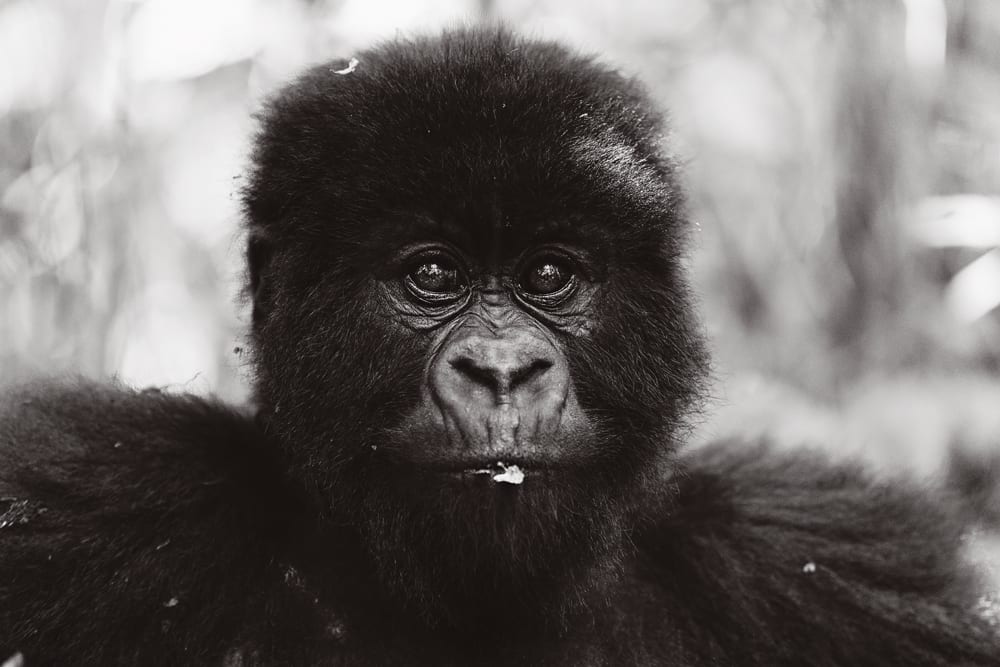
Dec 6
Birdsong woke us early the next morning – well, that, and the arrival of a thermos of hot water so that we could freshen up. :) Unzipping the giant canvas flaps of the tent, we saw that the clouds had resumed their guard over the distant peaks in Virunga National Park, but the scenery was no less breathtaking for it.
On the walk up the path to breakfast, I saw a trail of ants climbing the blacks rocks, so I stopped to look – not realising, of course, that I had stopped amongst the horde, which weren’t actually forming a trail, but rather a disorganised riot. I quickly learned that having rather large African ants climbing on your flip flops and clothing gives a whole new meaning to the phrase “ants in your pants.” Those suckers bite! Apparently, that morning marked the first ant invasion since the camp was rebuilt a few months ago. Our outdoor breakfast plans were moved indoors so that we could avoid the seething mass of ants on our former (natural) patio.
After breakfast – which was interrupted by several new ants-in-pants discoveries, we met Pierre, our ranger for our hike, who explained the details of gorilla tracking: when we are 200m away, we’ll be asked to put on our face masks in order to protect the gorillas from any possible spread of illness; keep 7m distance between you and the apes; we’ll be with them for 60 mins; if they charge or show signs of aggression, don’t run away – just look the other direction. And off we went.
We had two trackers who set off on the trail ahead of us with the responsibility of finding the gorillas’ nests from the night before; they are also tasked with the job of using their incredibly sharp machetes to clear a path through the jungle once the trail thins out, which happened within 20 minutes.
I had a brief moment of reflection on the genocide while watching the men use these brutally sharp tools to make exceptionally quick work of tree trunks that were about 4″ in diameter… Machetes are a part of life for many in Africa, but given what we’d learned in Rwanda, it was hard not to find their casual use for hacking shrubbery apart slightly disturbing.
The jungle is full of vines and plants that grab at your clothing, so we were glad of our long sleeves, and long pants are crucial for avoiding problems with water runoff from the plants and also those ever-friendly ants, should you run into some. We were expecting problems with nettles, but nothing we touched caused any stinging, so that was a pleasant surprise, as was the absence of rain.
We climbed uphill into towering bamboo glades; forced our way through vine-strewn jungle; tripped our way over concealed roots, rocks and fallen branches; and slid our way down a few muddy slopes. Whoops and squeals were semi-regular sounds as someone lost footing or “discovered” a rock, but it was all part of the fun and kept me laughing on what was, on a few occasions, a fairly grueling hike.
About 75 minutes after setting off, the trackers found the nests from the night before. While the apes would be impossible to find without some clue as to where they’d been the day before, once you see a gorilla nest, it’s pretty easy to figure out what’s been there. “Nest” really is an accurate word for what they create for themselves: leaves, vines, and branches are flattened into a shallow indentation in more or less a circle. When you see the nests off the ground (which is where they often are), it looks like a behemoth robin was there.
Seeing the nests amped up the anticipation levels; the trackers knew we were close. Another 15 minutes of walking and we came to an abrupt halt as a tracker pointed up into the tree just in front of us. There, about 15 feet off the ground, was a mammoth silverback doing his best King Kong impersonation in the fork of the lowest branches. It was difficult to believe that this enormous ape and the seven other members of the Munyaga family could be so close to us and we had no idea they were there.
Despite all of my excitement about this experience, I’d had no way of imagining what it would feel like to come upon these gigantic apes in the wild. “Awesome” doesn’t do it justice. I ceased to be aware of anything else around me; I was so focused on trying to take in what I was seeing: more than 600lbs of pure muscle suspended peacefully above our heads. The sheer power of this animal, holding itself parallel to a tree trunk with just its hands. He nimbly descended the tree after a few short, breathtaking moments and went to join the other seven members of his family: two more silverbacks – one of whom, oddly, is bald; three adult females; and two young ones (3 and 7).
We were in fairly thick jungle when we were with “our family” – thick enough that, at the beginning of our time together, our trackers had to change paths to find an accessible, ant-free route to join the apes, but they dutifully cleared vines and gestured for us to follow, while Pierre uttered a sporadic series of grunts to reassure the family that we meant them no harm. What followed was over an hour of a repeated grunt-slash-grunt-advance sequence as we followed this playful group through the undergrowth.
The youngest family member was a particular source of entertainment. He was prone to crawling up vines and branches to explore, but he had a remarkable habit of choosing branches unable to support his weight, meaning we saw him crash repeatedly – and comically – to the ground in a tangle of black hair, broken branches, and green leaves. He also seemed to enjoy spinning repeatedly in circles until he fell over; not unlike human toddlers, really!
Despite understanding that they are genetically very similar to humans, I was taken aback by just how human-like these great creatures’ gestures and behaviour are. A mother watched one of the young ones playing while she rested calmly on her belly with her chin in her hands – a pose echoed by a couple of the silverbacks on several occasions. We spent several moments in quiet awe of one of the females, who had curled up on her side, knees tucked up close to her body, hands pressed together under her head, eyes blinking very slowly in a pose of complete rest. During a group nap, one of the silverbacks lay quietly off to one side of the rest of the group, cuddling with one of the females.
There was one moment of aggression between two of the apes, during which one of the silverbacks chased another family member off, amongst a great deal of grunting and screeching. Seeing that happen, it became immediately clear how terrifying it would be to have one of these beasts charge me. It also became clear that standing my ground and looking the other way amidst such commotion is NOT an instinctive response. :)
Throughout our time with the family, I would periodically count them all, to see if we were missing anyone (a throwback to my teacher days, perhaps). When one was missing, it was invariably the older of the two young ones, who would end up being spotted overhead, climbing around the tangles of vines above the rest of the group, before occasionally performing a spectacular crash landing in their midst.
By the time we were forced to take our leave, we’d spent almost 75 unforgettable minutes watching these incredible animals. We took one last look as they walked off through the trees, and then we followed Pierre off into the jungle on our own route back to camp. The walk back was lighthearted, slippery, full of chatter, and and seemed to pass quickly as we took a shortcut to the edge of the park and through fields of potato and tobacco before climbing a hill to the back edge of the camp. Éméry, our camp host, mirrored our smiles as he asked about our visit with the gorillas. We settled into an enormous lunch, and then it was time to join Éric for the roller coaster ride back to Goma.
Thankful for: local knowledge, hiking boots








